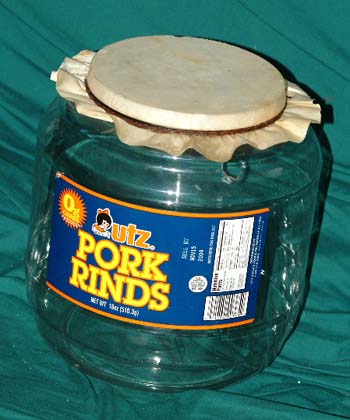Pork Rind Jar drum
 A
guitar player friend of mine thought of me one day as his associates
at work were tossing out the trash, and rescued this superlight
pork rind jar for my collection. Good eye, Guy Minervini!
Way to watch.. A
guitar player friend of mine thought of me one day as his associates
at work were tossing out the trash, and rescued this superlight
pork rind jar for my collection. Good eye, Guy Minervini!
Way to watch..
it sounded pretty good as an ideophone, but what the heck, we decided
to slap a head on it. The bottom thread came out ewnough to make
a good lip to work with.
We took a 10" goatskin and soaked it for about 15 minutes.
Holding it over the rim, we fashioned a slip knot, like you would
use on the end of a yoyo string for a finger loop. We put it around
the lip on the mouth of the jar, pulled it tight, making sure to
pull the skin evenly and remove all the wrinkles from beneath the
twine.
Normally a drop of superglue would have secured the line, but we
had none on hand. We had only Elmers wood glue, which would not
be enough to hold the twine. hmm..
Len thought a minute, then tied a piece of thin leather that had
been laying around onto the end of the twine. Two more times around
the rim, then the Elmer's, which soaked into the leather a little
better than it would have done with the twine. it worked like a
charm.
It dried, and sounded good, but needed to breathe more. We began
to experiment with the idea of a sound hole. With a hot punch, heated
on a gas stove, we made, then enlarged a hole in the side. This
helped a lot, although the plastic was so thin that it became hard
to keep the hole in round as we enlarged it. It retrospect, we might
have decided beforehand on the size of the hole and heated some
other metal item that would have made the hole more cleanly at the
desired size.
Please send
feedback. Thanks for looking..
stu
|

